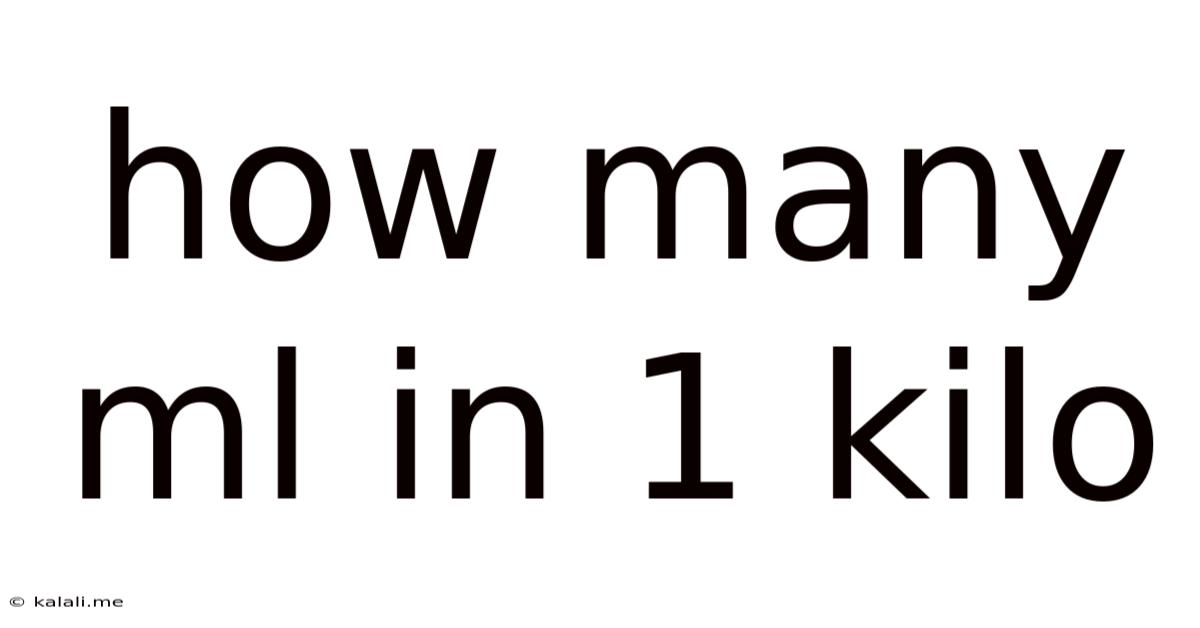How Many Ml In 1 Kilo
Kalali
Jun 11, 2025 · 2 min read

Table of Contents
How Many ml in 1 Kilo? Understanding Volume and Weight Conversions
Knowing how many milliliters (ml) are in one kilogram (kg) isn't a simple one-to-one conversion. This is because milliliters measure volume (how much space something occupies), while kilograms measure mass (how much matter something contains). The conversion depends entirely on the density of the substance you're measuring. Density is the mass per unit volume, often expressed as grams per milliliter (g/ml) or kilograms per liter (kg/L).
This means that 1 kg of feathers will occupy a much larger volume (and therefore have more ml) than 1 kg of lead, because feathers are much less dense than lead. There's no single magic number to answer "how many ml in 1 kg?".
Let's explore this further with some examples and calculations:
Understanding Density and its Role in Conversion
To convert between kilograms and milliliters, you need to know the density of the substance. The formula to use is:
Volume (in ml) = Mass (in g) / Density (in g/ml)
Since 1 kg = 1000 g, the formula can also be written as:
Volume (in ml) = 1000 g / Density (in g/ml)
Let's look at a few common substances:
-
Water: The density of water is approximately 1 g/ml (or 1 kg/L). This means 1 kg of water occupies a volume of 1000 ml (or 1 liter). This is a useful benchmark.
-
Milk: The density of milk is slightly higher than water, around 1.03 g/ml. Therefore, 1 kg of milk would occupy a slightly smaller volume than 1 kg of water, approximately 971 ml.
-
Oil: Oil has a lower density than water, typically around 0.9 g/ml. Therefore, 1 kg of oil would occupy a larger volume than 1 kg of water, approximately 1111 ml.
The Importance of Knowing the Substance
As you can see, the conversion is heavily dependent on what you're measuring. Trying to determine the volume without knowing the density is impossible. Always consider the specific substance when attempting this conversion.
Practical Applications and Examples
Understanding this conversion is crucial in various fields:
-
Cooking and Baking: Recipes often require specific volumes of liquids (like milk or oil), but ingredients might be weighed instead. Knowing the density helps in accurate conversions.
-
Chemistry and Physics: Accurate volume measurements are essential in many scientific experiments and calculations.
-
Engineering and Manufacturing: Density plays a critical role in design and production processes.
In conclusion, there isn't a universal answer to "how many ml in 1 kilo?". The conversion depends entirely on the density of the substance in question. Always refer to a density chart or use the formula provided to accurately calculate the volume. Remember, it's the density that bridges the gap between mass and volume.
Latest Posts
Latest Posts
-
How Much Does A Gallon Oil Weigh
Jul 01, 2025
-
How Many Crackers In A Sleeve Of Saltines
Jul 01, 2025
-
How Many Years Are In 48 Months
Jul 01, 2025
-
What Grade Is A 12 Out Of 15
Jul 01, 2025
-
The Opposite Of The Opposite Of Inexact Is
Jul 01, 2025
Related Post
Thank you for visiting our website which covers about How Many Ml In 1 Kilo . We hope the information provided has been useful to you. Feel free to contact us if you have any questions or need further assistance. See you next time and don't miss to bookmark.